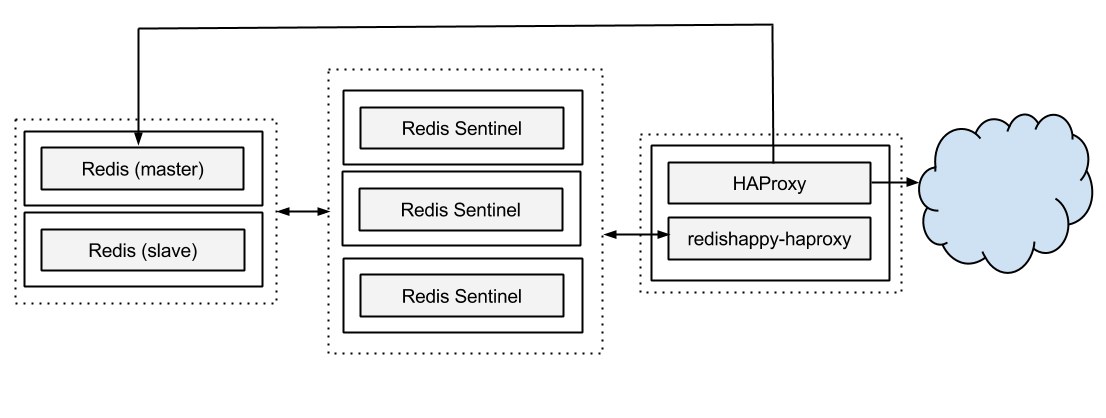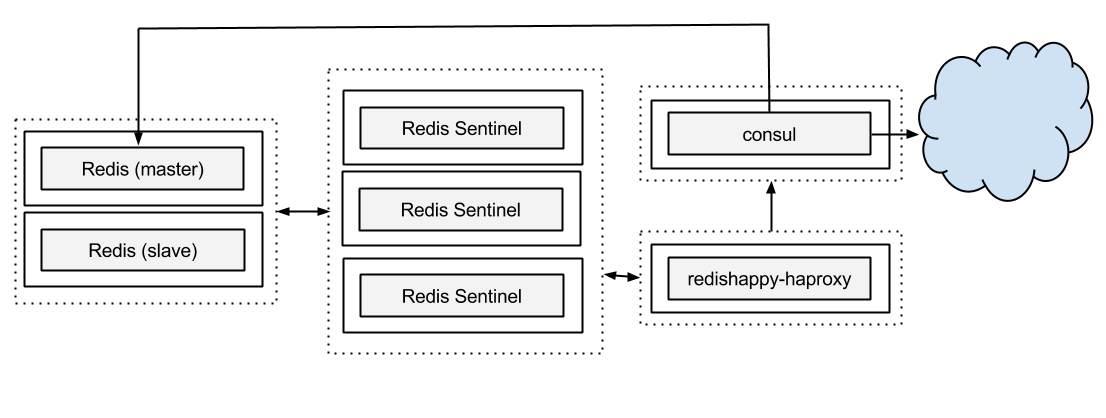One method of providing a highly available Redis service is to deploy using Redis Sentinel.
Redis Sentinel monitors your Redis cluster and on detecting failure, promotes a slave to become the new master. RedisHappy provides a daemon to monitor for this promotion and to tell the outside world that this has happened.
Currently we support HAProxy with redishappy-haproxy and Consul with redishappy-consul.
Features
- Automatic discovery and healthchecking of Redis Sentinels.
- Extensible to support various service discovery mechanisims
- Developed in Golang, clean deployment with no additional dependencies.
- Read-only RestAPI.
- Syslog integration.
- RPM and Deb packages available.
- Puppet module available.
Redishappy ships in two forms redishappy-haproxy and redishappy-consul.
redishappy-haproxy updates HAProxy's configuration file on Redis master promotion and then reloads the HAProxy configuration file. The reload maintains current connections.
The redishappy daemon is installed on the same machine as HAProxy and runs with correct user rights to interact with HAProxy. Multiple instance of HAProxy/redishappy-haproxy can be deployed and operate seperatly.
redishappy-consul updates entries in a Consul instance on Redis master promotion.
Q. Why - I thought in the modern age Redis clients should be Sentinel aware? They should connect to the correct Redis instance on failover.
A. Some do, some don't. Some it seems to be an eternal 'work in progress'. Rather than fixing all of the clients we needed to work correctly with Sentinel, RedisHappy was built upon the fact that all of the clients I have tested are great at connecting to a single address.
Operations teams also need to support legacy applications and libraries - adding redishappy, Sentinels and HAProxy can help provide a HA enviroment for Redis backed applications.
Q. Why - This article suggests that HAProxy can healthcheck Redis instances quite fine by itself.
A. Yes. It can do. But not reliably... I'll explain.
Suppose we have this setup. R1 and R2 are redis instances, S1,S2,S3 are Sentinel instances, H1 and H2 are HAProxy instances.
R1,R2
S1, S2, S3
H1, H2
- Life is good - R1 and R2 are in a master slave configuration, H1 and H2 correctly identify R1 as the master
R1 R2
M ---- S
^
|
---------
| |
H1 H2
- Disaster! - R1 dies or is partitioned but don't fear R2 is now the "master". Day saved!
* R2
M
^
|
---------
| |
H1 H2
- Disaster! - R1 comes back online and announces itself as a "master". Both R1 and R2 are now accepting writes, as HAProxy's healthcheck identifies both as online.
R1 R2
M M
^ ^
| |
---------
| |
H1 H2
- R1 is made the "slave" of R2. Everything is ok now, except for the writes that R1 accepted which are lost forever.
R1 R2
S ----- M
^
|
---------
| |
H1 H2
When a Redis instance is started and stopped it initially announces itself as a "master". It will some time later be made a "slave" but in the meantime accept writes which will be lost when it is correctly made a slave.
RedisHappy attempts to avoid this failure mode by only presenting the correct server to HAProxy or any other service once it is confirmed as a "master". We assume clients will either block or fail until the master is online again.
Using Vagrant
The provided vagrant file creates a virtual machine with all of the dependancies to build redishappy, smoke test it, and build the deb and rpm packages.
vagrant upThe packages are automatically built to - $GOPATH/src/github.com/redishappy/
The vagrant box also installs HAProxy, Docker and https://github.com/mdevilliers/docker-rediscluster for manual testing.
Download and build.
Install golang 1.4 +
go get github.com/mdevilliers/redishappy
cd $GOPATH/src/github.com/redishappy
go get github.com/tools/godep
go get github.com/axw/gocov/gocov
go get github.com/mattn/goveralls
go get golang.org/x/tools/cmd/cover
go get golang.org/x/tools/cmd/vet
go get golang.org/x/tools/cmd/goimports
godep restore
build/ci.shInstalling using the deb and rpm packages will set the following defaults -
- Installs to
/usr/bin/redis-haproxy - Configuration to
/etc/redishappy-haproxy - Logs to file in
/var/log/redishappy-haproxy - Warnings, Errors go to syslog
Example configurations can be found in the main folders
Definitions for the elements
{
// REQUIRED - needs to contain at least one logical cluster
"Clusters" :[
{
"Name" : "testing", // logical name of Redis cluster
"ExternalPort" : 6379 // port to expose for the cluster via HAProxy
}],
// REQUIRED - needs to contain the details of at least one cluster
// redishappy will discover additional sentinels as they come online
"Sentinels" : [
{"Host" : "172.17.42.1", "Port" : 26377}
],
// OPTIONAL for running redishappy-haproxy
"HAProxy" :
{
// REQUIRED - absolute path to the template file
"TemplatePath": "/var/redishappy/haproxy_template.cfg",
// REQUIRED - absolute path to HAProxy's config file
"OutputPath": "/etc/haproxy/haproxy.cfg",
// REQUIRED - command to run to reload the config file on changes
"ReloadCommand": "haproxy -f /etc/haproxy/haproxy.cfg -p /var/run/haproxy.pid -sf $(cat /var/run/haproxy.pid)"
},
// OPTIONAL for running redishappy-consul
"Consul" : {
// REQUIRED - path to Consul instance
"Address" : "127.0.0.1:8500",
// REQUIRED - for each cluster in the main config there should be a defined service
"Services" : [
{
// REQUIRED - should match a name of a Cluster in the main config
"Cluster" : "testing",
// REQUIRED - logical name for the node
"Node" : "redis-1",
// REQUIRED - logical name for the data centre
"Datacenter": "dc1",
// REQUIRED - tags for the service
"tags" : [ "redis", "master", "anothertag"]
}
]
}
}Or you can configure with the following environmental variables -
| Environment Variable | Example | Notes |
|---|---|---|
REDISHAPPY_CLUSTERS |
clustername:6379 | multiple values can be ; seperated |
REDISHAPPY_SENTINELS |
ip_name:26377 | multiple values can be ; seperated |
REDISHAPPY_HAPROXY_TEMPLATE_PATH |
string, see config file for example | |
REDISHAPPY_HAPROXY_OUTPUT_PATH |
string, see config file for example | |
REDISHAPPY_HAPROXY_RELOAD_CMD |
string, see config file for example |
RedisHappy provides a readonly API on port 8000. You can change the port by specifying a PORT environment variable. It is also possible to use a BIND environment variable if you wish to bind to other interfaces etc.
GET /api/ping- will reply "pong" if runningGET /api/configuration- displays the start up configurationGET /api/sentinels- displays the sentinels being currently monitored and their current statesGET /api/topology- displays the current view of the Redis clusters, their master and their host/ip addresses
redishappy-haproxy provides the following additional read only apis
GET /api/template- displays the current template fileGET /api/haproxy- displays the rendered HAProxy file
Running the following script will gofmt, govet, run the tests, build all of the executables.
build/ci.shhttps://github.com/mdevilliers/docker-rediscluster
Will start up a master/slave, 3 sentinel redis cluster for testing.
Big thanks to
- Pierig Le Saux for providing the RPM packaging and Puppet expertise
- Gary Hawkins for providing the deb packaging expertise
- Dominic Scheirlinck for fixing up the consul deb package
Code and documentation copyright 2015 Mark deVilliers. Code released under the Apache 2.0 license.


